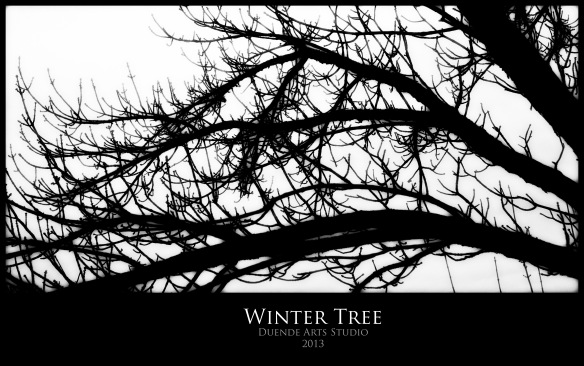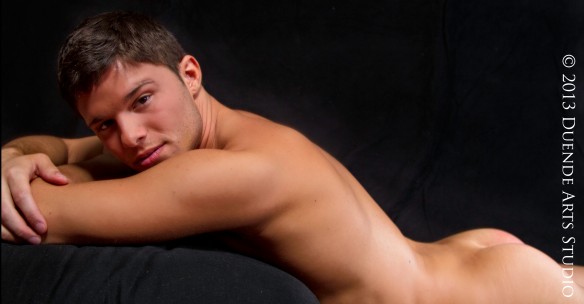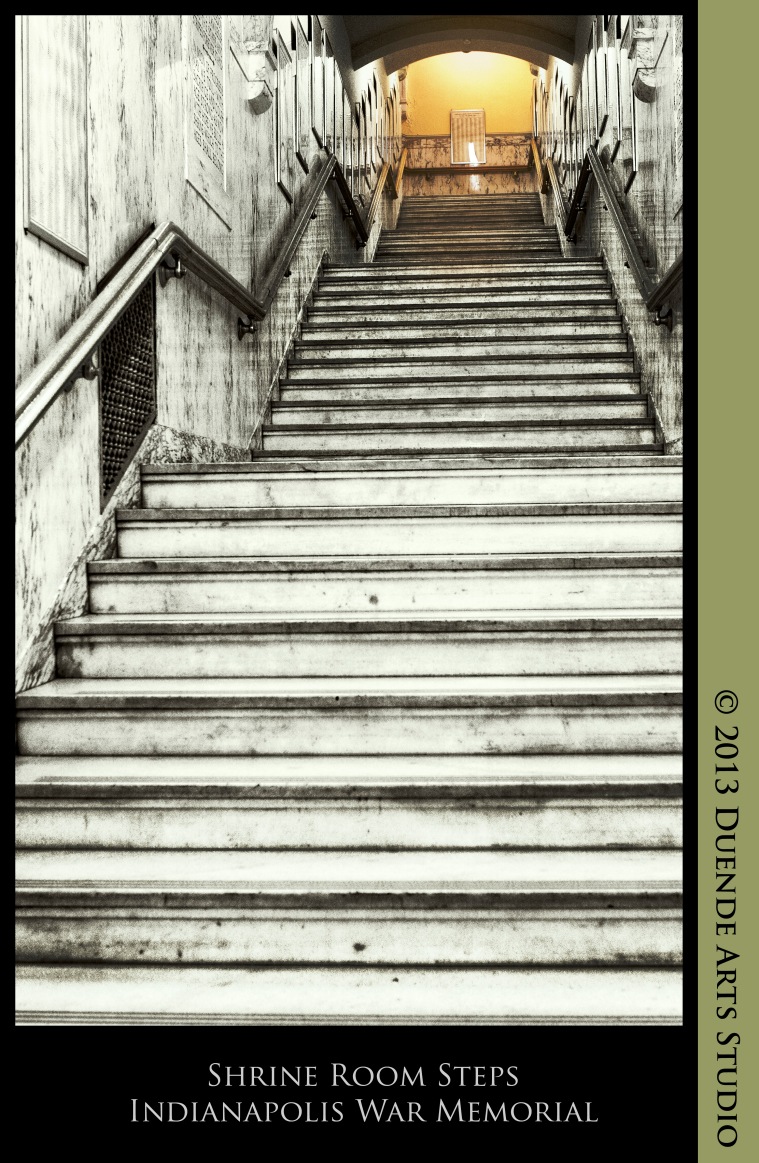
I took this picture through the living room window just now. It surprised me. It looks just like what I wanted to shoot. I wanted an image for the kind of day we are having here in Indianapolis. The sky is amorphous gray, featureless so the eye can latch on to nothing. The air is completely still. Outside, aside from the sky, there is nothing but more gray, a grayscale image going from black to white. No emotion.
But no, even when it’s all gray, there is emotion. As long as the scene is viewed by a human being there is emotion. Because emotion is not in the image, is not in the stimulus that triggers a sight, a sound, a taste, or a combination of sensations. Emotion is generated in the human mind. And to me art involves emotion.
That’s not what everybody believes about art. Artists in the Middle Ages certainly were not thinking of art as involving emotion. What art there was in Europe at the time was to teach unlettered people about Christian belief that they might be saved. In the Renaissance art still featured biblical subjects but the classic images of Greece and Rome began to filter in and artists began to theorize about beauty. Beauty was what they saw in classical art, but with a dollop from each artist’s own personality. Thus Michelangelo with his love for the masculine body would paint even angels and women with the muscularity of men. Art was beauty as the artist saw it, and only a little of what his patron was paying him to produce!
The subject matter of art changed with the times. In the decades following the mercantile success of Florence, other parts of Europe began to enjoy prosperity and wealth. Merchants were now the moneyed class, employing artists to immortalize their portraits, their homes, their ideas. Artists ever more free from canons dictated by church-sponsored works explored other ways of depicting beauty. Over time new canons took shape and became established as dogma. Until the impressionists came and the world of representational art broke into smithereens. Beauty itself was now insecure. Art didn’t have to be beautiful. It still had to be “true” but what it was true to everybody no longer agreed. In Europe, North America and now in every part of the world, visual artists are seeking ways of expressing their inner visions through a multiplicity of media – oils, acrylics, wood, fabric, photographs and now pixels!
All of that is beyond me, impractical and so much useless chatter. What is it that I want to portray in a mixture of photographic captures and digital editing?
The human being brings a part of himself into the process of creating any work, whether we call it a skyscraper, a Filipino menudo, an Impressionist painting, or a jazz improvisation. His work shows his mark, what Herman Hesse called “the mark of Cain.” Most of us spend our lives becoming as similar to others as we can be. Or we spend our time trying to be the image of a man or woman we have in our heads. But some of us march to an even more essential drummer. The drum beat he hears is not of this world. To hear it he must let go his fears, his reliance on simple reason and his own puny resources. To hear the music of the spheres, he must take a leap of faith, jump off the known into the unknown.
Only when an artist can produce something the world has not seen before can he claim to be an artist. The work has to show its intimate relationship to the world as we “know” it but it must include something of the producing artist or it will be nothing but paint-by-numbers or generic art like the various salicylate products we can now buy without buying Bayer’s Aspirin.
Even as a child I was fascinated by the world around me. The world inside me was even more interesting. No wonder I gravitated to psychology, the study of mind. For 35 years I earned a living using doctrines of Western psychology to help others find a measure of peace or balance in their lives and relationships. But clinical psychology or its medical counterpart that I practiced was not where my passion lay. I did it because I had to.
I paid my dues. Now I can hone in closer to my desire. But do I even know what that desire is? And how do I go after it? Will I recognize it when it appears?
My mind is a jumble of ideas and images, of thoughts, memories and sensations. I am starting to think that none of these matters. Putting together a theory is useful but not to bring our life’s desire into view. Writing up theories is in itself a work of creation. It’s awesome when some part of it appears to work, when we see it work in our lives. But the nagging though remains: there is more.
In 1912, Oxford Professor, Gilbert Murray, wrote a short book called Four Stages of Greek Religion. In 1925 he revised the book by adding a fifth stage, his book now called Five Stages of Greek Religion. It is the 1951 edition of the book with Professor Murray‘s long Introduction to the Third Edition that came into my hands several years ago. One night this week when sleep was playing hide and seek with me I started to read the book again.
Murray’s book contained many ideas that found resonance with my own nearly 70 years of living. He held that what we studied as grade school and high school students as Greek Mythology was the ancient Greek’s religion, as much religion to them as Christianity or Islam or Hinduism is to contemporary men and women. I knew that from the 1980s when I started studying religions other than Christianity. I remember the moment when the insight hit me with a force of recognition that even today shakes my world. What we impute as mythology to our true religion is mythology to someone else, to a serious student of the phenomenon of religion.
Murray also held that the religion a person today believes in and practices contains within it elements of older religions. We throw away some elements irrelevant in our times but there are elements we doggedly hold on to often without our consciously knowing we are doing this.
Carl Jung created the concept of the Collective Unconscious, some intangible creation of all the human beings who have come before us, a common collection of everything that has passed into the psyche through some person’s eyes or ears or touch or tongue to become Memory.
To Murray religion was about those realms of human activity outside of what we have studied or think we know. “All around us,” he wrote, “on every side there is an uncharted region, just fragments of the fringe of it explored, and those imperfectly; it is with this that religion deals.”
Art may be what religion was to people in our gradually vanishing past. Through their work artists remind others what else there is in the mind of man that moves him, fills him with something more than what the daily news elicit or what he experiences when he completes a deal on Wall Street or Makati Avenue. Art comprises all the works of man’s imagination that comes out of the depths of his being, like Minerva from her father’s head, full-grown and in full possession of the wisdom – literature, music, science, physics, philosophy itself, and theology. Art is the only thing perfect in our imperfect universe!
Murray held that the study of Greek mythology was crucial to understanding not only our own modern-day religions but understanding what it is to be human. From times immemorial (that is, beyond memory) other humans have attempted to understood themselves and the world they knew through their physical senses. Some humans wrought their understanding into objects we can still view today and view with a sense that we are seeing something true, so alive that those who participate in our act of creation see their own Big Bang in a dollop of paint, a page of inert words, a handful of pixels.
More theories.. The mind is relentless as it weaves thoughts and more thoughts. Even so I like this image of a Medusa of branches snaking against a colorless sky! It’s how I feel about this gray undistinguished winter day in Indiana 2013.
0.000000
0.000000










